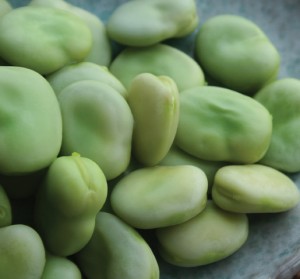×


We have detected your country as:
Please click here to go to the USA website or select another country from the dropdown list.
A joint study by researchers of the Weizmann Institute and the Israel Antiquities Authority (IAA) examined fava seeds (broad beans) found in archaeological excavations in recent years at Neolithic sites in the Galilee in northern Israel. Seeds found at the prehistoric sites show that the inhabitants’ diet at the time consisted mainly of fava beans, as well as lentils, various types of peas and chickpeas.
The large number of fava seeds found at the Neolithic sites previously excavated in the Galilee during the past few years indicates the preference placed on growing fava beans. The dating of the seeds, which was done at the Kimmel Center in the Weizmann Institute, indicated that the beans were between 9,890 and 10,160 years old. These well-preserved seeds were found in excavations, inside storage pits (granaries) after they had been husked. The seeds’ dimensions are a uniform size showing they were methodically cultivated, and were harvested at the same period of time, when the legumes had ripened. According to the researchers, keeping the seeds in storage pits is also reflective of long-term agricultural planning, whereby the stored seeds were intended not only for food, but also to ensure future crops in the coming years.
 The researchers added, “The identification of the places where plant species that are today an integral part of our diet were first domesticated is of great significance to research. Despite the importance of cereals in nutrition that continues to this day, it seems that in the region examined (west of the Jordan River), it was the legumes, full of flavor and protein, which were actually the first species to be domesticated. It is now clear that the area that is today the Galilee was the main producer of legumes in prehistoric times. It is interesting to note that even today most of the chickpeas grown in the country are cultivated in the Galilee region”.
The researchers added, “The identification of the places where plant species that are today an integral part of our diet were first domesticated is of great significance to research. Despite the importance of cereals in nutrition that continues to this day, it seems that in the region examined (west of the Jordan River), it was the legumes, full of flavor and protein, which were actually the first species to be domesticated. It is now clear that the area that is today the Galilee was the main producer of legumes in prehistoric times. It is interesting to note that even today most of the chickpeas grown in the country are cultivated in the Galilee region”.
Source: Excerpts of article by Edgar Asher, Ashernet
Photo Credit: Ashernet/IAA
All logos and trademarks in this site are property of their respective owner. All other materials are property of Bridges for Peace. Copyright © 2025.
Website Site Design by J-Town Internet Services Ltd. - Based in Jerusalem and Serving the World.